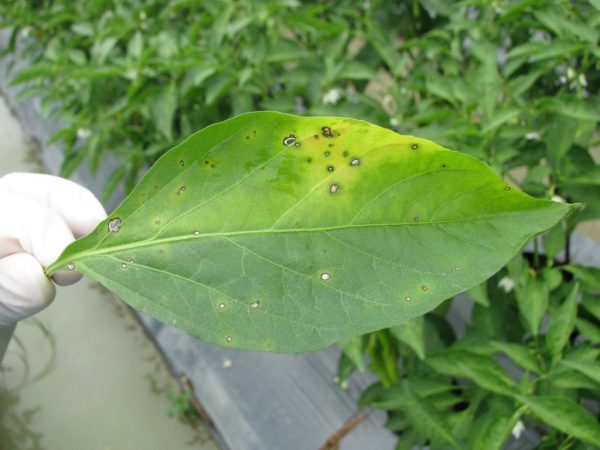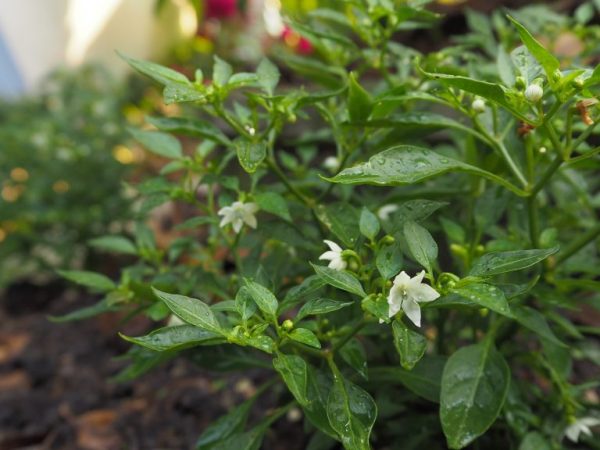Why pimples appear on pepper leaves
The appearance of the leaves is the main indicator of the health of the plant, instantly revealing the presence of infections, pests or mistakes in care. Bumps on pepper leaves occur quite often. They can be caused by various reasons, from completely harmless to leading to death.

Causes of pimples on pepper leaves
Causes of education and symptoms
Bumps on leaf plates occur due to the presence of one of the following problems:
- oedema (leaf edema);
- scale insect or aphid;
- thrips;
- spider mite.
To correctly determine the source of tubercle formation, it is necessary to carefully examine the affected leaf plate using a magnifying glass. Moving pimples indicate the presence of aphids, motionless brown (less often green or cream) - scale insects. White or greenish bumps that look like warts are a symptom of foliage swelling. White blisters and cobwebs are formed when infected with spider mites, and lightened spots on stems and leaf plates are formed when infected with thrips.
In addition to the color characteristics of the tubercles, each type of leaf lesion has a number of other symptoms. From them you can understand what the problems are connected with.
Oedema
The cause of physiological edema is a failure at the cellular level, due to which the liquid does not have time to be absorbed by the leaves and stagnates in the form of tubercles. This process can be triggered by such factors:
- excess moisture in the soil;
- hypothermia of the root system;
- lack of sunlight or additional light;
- high air humidity;
- stress due to a sharp change in temperature and light conditions;
- too tight planting of the shoots to each other.
In oedema, green or white tubercles look like watery capsules, dense to the touch. If too many of these pimples form on the leaf blades, the leaves turn yellow and fall off.
Scabbard and aphids

Aphids are easy to spot
The main sign of damage by these pests is the presence on the foliage of a sticky substance (pad), produced in the process of insect life. Seedlings can become infected from the soil or due to the proximity to already diseased crops.
Symptoms of aphids or scale insects in pepper:
- growth arrest under proper care conditions;
- twisting and yellowing of leaf plates;
- slowing down the growth of sprouts;
- the presence of a honeydew;
- a large number of larvae and adult insects on the inner side of the leaf.
Thrips
The main external sign of pepper damage by these insects is lightened spots, which over time begin to merge into one. Several generations of pests are formed during the year. Seedlings infested with thrips quickly weaken and die without proper care.
Thrips are masked on the leaf, located on the back of it.Without a special examination, it is extremely difficult to notice the defeat of these insects at an early stage, but the larger the population becomes, the easier it will be to determine the infection by the yellow color and openwork mesh of leaf plates.
Spider mite
Spider mites mainly inhabit the lower part of the leaf blades, occupying the entire plant as they become infected. Adults (10-20 days from the moment of oviposition) very quickly migrate from one bush to another, capturing the entire landing area.
The tubercles, when infected with a spider mite, are located on the underside of the leaves, and a thin cobweb entwines parts of the shrub. At the extreme stage of damage, the plant can be completely covered with cobwebs. It should be borne in mind that these pests are carriers of a large number of serious viral infections and fungal diseases that are dangerous to plant life.
Control methods
Pimples on pepper seedlings can be a herald of serious problems and even plant death. All the more important is timely intervention and a set of measures aimed at improving culture.
The choice of effective methods of struggle completely depends on the causes of the appearance of pimples. It is also important to consider the general condition of the plant. Sometimes pests have to be removed manually.
Actions for leaf swelling

It is important for plants to create favorable conditions
Swelling of the leaves is not a disease, therefore, does not imply treatment, but the following measures should be taken to alleviate the condition of the seedlings:
- limit the number of waterings;
- maintain an optimal temperature regime of the air (about 20 ° C);
- organize drainage holes in containers with seedlings to drain excess moisture;
- lengthen the duration of daylight hours by connecting daylight bulbs;
- temporarily cancel fertilization;
- control the acidity of the soil;
- distribute the seedling bushes in such a way that there is sufficient air circulation and all the seedlings have access to light.
The complex of these actions helps to avoid the formation of pimples in the future, if unfavorable environmental conditions served as their cause.
Actions in case of pest infestation
If pimples on the leaves of pepper seedlings appear due to harmful insects, it is necessary to promptly carry out a set of measures to combat them:
- Chemical measures - treatment of the plant with synthetic insecticides (preparations for the destruction of insect pests). This is the most effective method, potentially hazardous to human health, and requires additional safety measures.
- Physical measures - rinse with soapy water or alcohol, or kill insects by hand.
- Biological measures - the use of biological enemies against pests (insects and birds) or the use of microbiological preparations.
- Natural insecticides - folk recipes, tinctures and decoctions (based on garlic, onions, pepper, tobacco, laundry soap, ash, wormwood, ground red pepper, kerosene, ammonia, etc.).
When treating a plant, the individual characteristics of each insect species should be taken into account. For example, trixs are extremely resistant to any control measures and require at least 2 treatments in one season (with the use of several drugs at the same time). It is much easier to get rid of a spider mite: it is enough to water the seedling abundantly and put a plastic bag on it for a couple of days, because these insects do not tolerate moisture very well.
A change in external conditions also contributes to a decrease in the population of insect pests: the introduction of moderate watering, frequent ventilation, isolation of infected plants. The success of the fight depends not only on the use of the correctly selected remedy, but also on when it was started to be used.
Prevention of the formation of pimples
The problems associated with the formation of tubercles during the cultivation of pepper seedlings can be avoided by methodically carrying out a set of preventive measures. We include:
- disinfection of seed (with potassium permanganate solution, ash, "Baktofit" or "Albit");
- thorough loosening and mulching of the soil;
- preventive use of insecticides or folk remedies (twice a season);
- development and use of an optimal watering and humidification system;
- regulation of plant access to light, the use of additional lighting sources;
- using land with a good drainage system (drainage should take at least a quarter of the pot);
- regular inspection of the plant for the detection of pests (special attention is paid to the underside of the leaf plates).
The systematic implementation of preventive measures helps to prevent and detect infection of sprouts at an early stage, which greatly increases the chances of recovery.
Conclusion
Bumps on the leaves are a common sign of unhealthy seedlings. The appearance of pimples can be provoked by the defeat of the plant by pests or a violation of the growing conditions. Timely measures taken can save pepper seedlings and contribute to the formation and ripening of a rich harvest.
These problems are often faced by novice vegetable growers. By adhering to the recommendations for care, they can be avoided.


